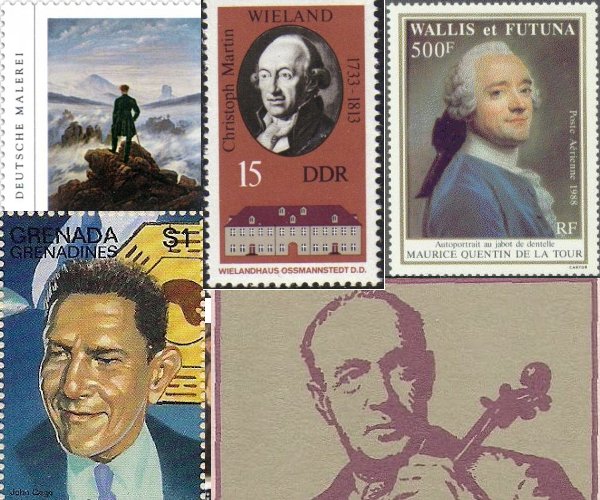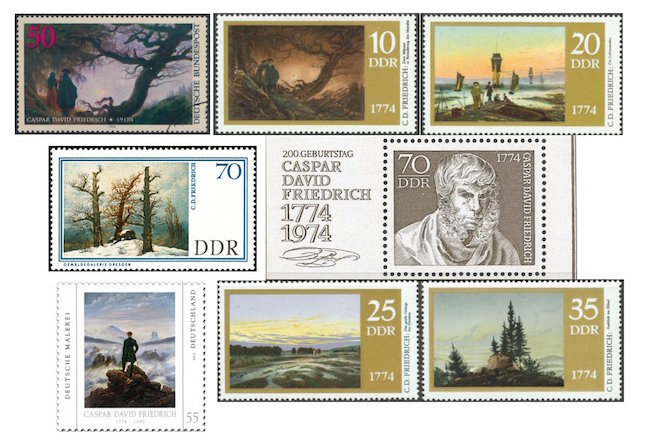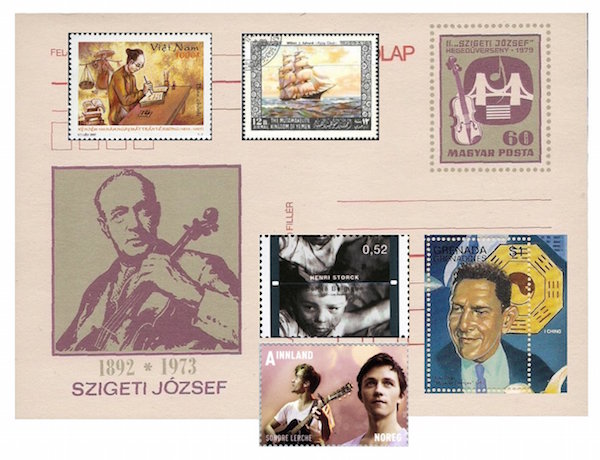The Arts on Stamps of the World — September 5
An Arts Fuse regular feature: the arts on stamps of the world.

By Doug Briscoe
Today marks the sesquicentennial of the birth of American composer Amy Cheney Beach (September 5, 1867 – December 27, 1944), but she still has no stamp. I was also surprised that no stamps seem to exist for opera composer Giacomo Meyerbeer (1791-1864) nor for Russian poet Aleksey Konstantinovich Tolstoy (September 5 [O.S. August 24] 1817 – October 10 [O.S. September 28] 1875), though there are plenty for his cousin, as we shall see in a few days.
That leaves German nature painter Caspar David Friedrich (5 September 1774 – 7 May 1840) as today’s most prominent artist on stamps. He was the pre-eminent German painter of the 19th century, but was not recognized as such during his lifetime. Certainly he received some plaudits, but nothing like his deserts. And that was only part of his tragedy: he lost his mother at seven, a sister at eight, and a brother, whom he saw fall through the ice, possibly while trying to save Caspar, at thirteen. Born on the Baltic Sea, he studied at Copenhagen and lived at Dresden and Weimar. He didn’t produce his first major painting, The Tetschen Altar, or The Cross in the Mountains until he was 34 (1807). One of his best known works is shown in two variants on two German stamps, one from the BRD and one from the DDR. The East German stamp, part of a set of four with accompanying souvenir sheet, offers the original 1819 version of Two Men (reputedly Friedrich himself, at right, and his pupil August Heinrich) Contemplating the Moon; the West German one shows Man and Woman (Friedrich and his wife?) Contemplating the Moon (1824). For a look at all three versions—the last one is from c1825-30—with analysis, go to this informative Artble page. The other paintings in the DDR set are, at upper right, The Stages of Life (Die Lebensstufen, 1835); at bottom, beneath the drawn Self-Portrait of 1810, are The Great Preserve at Dresden (1832) and View into the Elb Valley (1807). The other, earlier DDR stamp of 1967 reproduces Cairn in Snow (Hünengrab im Schnee, 1807), and the West German one at bottom left, another of Friedrich’s most recognizable works, is Wanderer above the Sea of Fog (1818). Finally, the only non-German stamp I found (go to the second collage, please) was this Russian one of On Board a Sailing Vessel (Auf dem Segler, 1818), which is in the Hermitage in Saint Petersburg. Other well known Friedrich paintings—they are often used on classical music album covers—are Rocky Landscape in the Elbe Sandstone Mountains (1822-23), Chalk Cliffs on Rügen (1818), and The Abbey in the Oakwood (Abtei im Eichwald, 1808–10).

We treat briefly with the Italian theologian and philosopher Tommaso Campanella (5 September 1568 – 21 May 1639), who also wrote some sonnets and other poems, including one for the infant prince who would within a few years rise to the throne of France as Louis XIV. (That great patron of the arts also happens to have been born on 5 September, Campanella’s birthday, in 1638.) Campanella was a child prodigy whose questioning mind eventually led to charges of heresy and, after repeated torture by the Inquisition, a lengthy imprisonment of 27 years, during which time, however, he was permitted to write several volumes including his most celebrated work, the utopian dialogue The City of the Sun (1602). Eventually Campanella was released through the efforts of Pope Urban VIII and found favor at the court of Louis XIII. (Thus the poem for the dauphin.)
French portrait painter Maurice Quentin de La Tour (5 September 1704 – 17 February 1788) also created art for royalty, indeed for the same family, having left portraits of Louis XV and other Bourbons. A recent stamp in honor of Madame de Pompadour uses his portrait (c1749-55) of her. He also captured Voltaire, Rousseau, and other notables on canvas. Quentin de la Tour grew rich and was a generous philanthropist. He was afflicted with dementia in his later years. The stamp from Wallis and Futuna shows his good-natured Self-portrait with Lace Jabot (c1751). Some of you d’un certain âge may recall the old French 50-franc banknotes with his image.
We have two stamps for German poet Christoph Martin Wieland (5 September 1733 – 20 January 1813). He was conversant with Latin and French by the mid-teens. His early pietistic verse gave way to works of the imagination, poems, plays, and the novel Geschichte des Agathon (1766–1767), a Bildungsroman and psychological novel. Wieland also translated twenty-two of Shakespeare’s plays at around this time. After serving as a philosophy professor at Erfurt he was engaged to tutor the sons of the German princess (and composer) Anna Amalia at Weimar. There his literary review Der teutsche Merkur (The German Mercury) drew such other men of letters as Goethe, Herder, and Schiller to the city. Wieland took to writing opera librettos, and one of his romances, Oberon, served as the basis for Weber’s opera of the same name (1826). Besides his industrious Shakespearean translations, he also translated Horace, Lucian, and Cicero into German. His own poems, however, did not resonate with the great Lieder composers of the 19th century.

Another poet is up next, though his main claim to fame was the authoring of the lyrics to the national anthem of Italy, Il Canto degli Italiani (music by Michele Novaro). There might have been better things in the offing had not Goffredo Mameli (5 September 1827 – 6 July 1849) died of an infection from an accidental wound in his leg at the age of 21. He was an ardent and energetic nationalist who fought with Garibaldi and directed an anti-Austrian newspaper. Italy remembered him on the occasion of the centenary of the Risorgimento with a stamp depicting “The Death of Goffredo Mameli”, and that stamp, along with one for the centenary of the Roman Republic, was recreated to commemorate Mameli again fifty years later. One of Mameli’s other poems, by the way, “Suona la tromba” (“Sound the Trumpet”), was set to music by Verdi in one of his lesser choral works.
I was not able to learn much about the Vietnamese poet Trần Tế Xương (5 September 1870 – 29 January 1907), commonly known as Tú Xương, except that he wrote satirical verses mocking those who supported French colonialism. He, too, was short-lived, achieving only the age of 37. The stamp was issued for the one hundredth anniversary of his death.
American nautical artist William Aylward (September 5, 1875 – February 26, 1956) was born in Milwaukee and knew ships from his father’s shipbuilding business on the Great Lakes. He was a student at the Art Institute of Chicago and had Howard Pyle as one of his teachers. In addition to contributing to magazines, Aylward illustrated reprints of sea stories like Jules Verne‘s Twenty Thousand Leagues Under the Sea and The Sea-Wolf by Jack London. During World War I he was an official artist for the U.S. Army. The Yemeni stamp shows his picture of Flying Cloud, a ship that held the world record for the fastest passage by a sailing ship between New York and San Francisco for over 100 years, from 1854 to 1989.

The great Hungarian violinist József Szigeti (SIG-eh-tee, 1892 – 19 February 1973) has no proper stamp, but at least there’s a postal card from 1979. He left many recordings of his artistry and was the dedicatee of works by Ysaÿe (Solo Sonata No. 1) and his friend of many years Béla Bartók (Rhapsody No. 1).
Primarily a documentarian of short subjects, Belgian filmmaker Henri Storck (September 5, 1907– September 17, 1999) started making films in 1929. He also appeared as an actor in a few pictures, most notably as a priest in Jean Vigo’s Zero for Conduct (1933). Storck’s only feature-length dramatic film was a crime story, The Smugglers’ Banquet (Le Banquet des fraudeurs, 1952). His last film, co-directed with Patrick Conrad, was a full-length documentary on the Belgian artist Constant Permeke. The stamp shows a still from his 1933 socialist documentary on coal miners Misère au Borinage.
The controversial American composer John Cage (September 5, 1912 – August 12, 1992) has not been recognized on a stamp of the United States (surprise!), but he does appear on one issued by Grenada Grenadines in 1996; this comes from a sheet honoring nine composers. Cage studied with Henry Cowell and Arnold Schoenberg, but was sufficiently knowledgeable about art to accept a position teaching at the Chicago School of Design in 1941. This was at the invitation of László Moholy-Nagy. Cage to all intents and purposes invented the prepared piano and often consulted the I Ching for his compositions. His life partner for nearly half a century was American choreographer Merce Cunningham.
Today is also the birthday of Norwegian singer/songwriter Sondre Lerche (born 1982). His inclusive style encompasses rock, jazz, folk, and pop, and as a guitarist he has toured with Elvis Costello. Lerche has released a dozen albums since 2001 and has made New York City his home since 2005.
A happy birthday to the great German director Werner Herzog (born 5 September 1942) and to the great Canadian-American pianist Marc-André Hamelin (1961).
A graduate of the University of Massachusetts with a B.A. in English, Doug Briscoe worked in Boston classical music radio, at WCRB, WGBH, and WBUR, for about 25 years, beginning in 1977. He has the curious distinction of having succeeded Robert J. Lurtsema twice, first as host of WGBH’s weekday morning classical music program in 1993, then as host of the weekend program when Robert J.’s health failed in 2000. Doug also wrote liner notes for several of the late Gunther Schuller’s GM Recordings releases as well as program notes for the Boston Classical Orchestra. For the past few years he’s been posting a Facebook “blog” of classical music on stamps of the world, which has now been expanded to encompass all the arts for The Arts Fuse.
